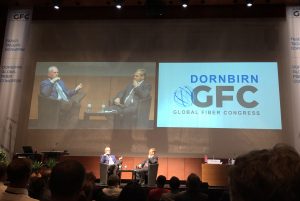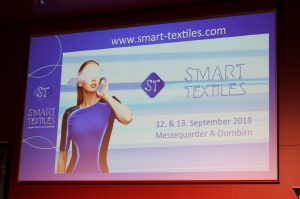Smart Textiles Symposium 2018 (September 12 & 13)
The 7th Smart Textiles Symposium 2018 (September 12&13) had taken place simultaneously with GFC-Dornbirn (September 12-14). Around 160 participants came to the Messequartier Dornbirn to meet with professionals from the smart textiles community and to learn from the 25 top speakers during the 2 days conference. The former Federal chancellor from Austria, Werner Faymann, urged industry representatives in his opening words to be always one step ahead in the competition and to take advantage of recent market opportunities. From 2008 until 2016 he was managing current affairs of the Austrian government and since 2017 he became a true entrepreneur and started his consulting business.
James Holbery, Microsoft USA
Keynote speaker James Holbery from the the 90 billion US$ company Microsoft based in Redmont, USA, gave an interesting insight in Microsoft’s recent activities in printed, textile and flexible electronics and the current focus on creating new user experiences through soft electronics. “We always have to reinvent ourselves in these days of rapid change. We want to bring personal computing to a new level and address the young generation in particular. The interesting thing about computing is the tremendous development we are facing and when we think about IoT and increasing digitization there is a lot more to come.” It is interesting that after the recent cooperation between Google and Levi’s another gatekeeper is now taking a deeper interest in textiles. James Holbery has been responsible for building up the new Microsoft lab for printed, textile and flexible electronics (PTFE).
Artificial Intelligence and Chatbots
Dr. Isa Hofmann, moderator of the first day, also gave a lecture on new opportunities in customer communication through artificial intelligence – from social bots to chatbots. The use of artificial intelligence is the next big thing. According to EU commission statistics the growth of this market will climb up to 38,8 billion US$ in 2025. Artificial intelligence allows machines to behave as if they were intelligent and supplies them with the ability to always learn more and something new. This is the big difference with regards to conventional software. Chatbots allow an automated communication with customers in real time. They are an appropriate tool to relieve staff members and generate an added value in customer relationship. Communication in real time without any waiting loops. Isa Hofmann presented the results of a recent study from business school Cologne and the agency morefire, that tried for the first time to classify existing chatbot types.
“How wonderful it would be if we could combine the scientific and technological achievements of the West with the asceticism and humanism of India!”
Unni Krishnan, Co-Founder of LongWealth GmbH with offices in Vienna and Bangalore is consulting large groups like Tata and Taj in India. Krishnan referred to a famous encounter between Swami Vivekananda, an Indian spiritualist and a leading industrial representative at the end of the 19th century. Impressed by Vivekananda’s views on science the first idea of establishing a research institute in India was born by the end of the 19th century. Endowed with a vision for the future, Vivekananda commented this idea with the following words: “How wonderful it would be if we could combine the scientific and technological achievements of the West with the asceticism and humanism of India!”
LongWealth GmbH supports Austrian sme’s to enter the Indian market. India, a country full of contradictions, belongs to the world’s fastest growing economies and offers multiple opportunities for innovative Austrian companies according to Unni Krishnan.
Examples of in textiles integrated electronics
Stefan Rohringer, Vice President Development Center Graz, Infineon Technologies Austria AG pointed out the very first examples of electronics integrated into textiles that Infineon presented in 2003. Researchers at Infineon had discovered a way to make large textile surfaces such as carpeting or tent cloth “intelligent”. Woven into fabrics, a self-organizing network of chips was able to monitor temperatures, pressures or vibrations. “This shows that you also might introduce things too early to the market”, Rohringer comments. He presents the next generation of quantum computers that provide the necessary security in times of smart payment and IoT. He predicts 28 billion connected devices in 2021. That means a new era of internet security is really important.
The rest of the day was taken up by interesting lectures from start-ups presenting successful business models like smart inlay soles from the company stAPPtronics that help wearers to control their body posture. Texible, a start-up, is a think tank for interesting new applications of smart textiles for the elderly. The demographic change creates new requirements. One example are smart bed inserts for humidity control. Florence Bost, French designer based in Paris demonstrated how the appropriate design may enhance news and tangible services in products.



